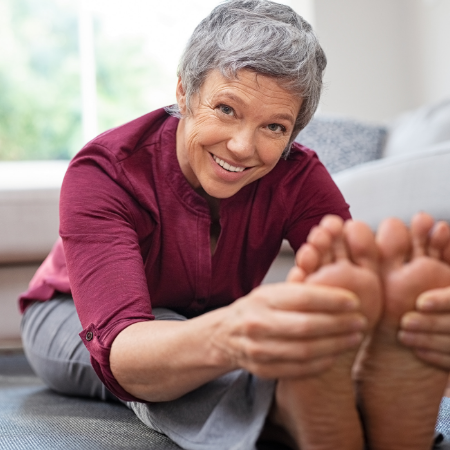What Happens When You Don’t Stretch

For well over 2 years now, Bob and I have taken 20 minutes nearly every day to do a stretching routine from www.Oxycise.com. (We ordered the streaming videos that allow you to pick and choose.) I’ve mentioned this excellent program many times. We make no money from this. We just think it’s THAT important.
Although it’s marketing is geared towards body sculpting and weight loss, the benefits go far beyond that. Quite honestly, I don’t think either of us has even had a serious cold since we started these!
Because of these exercises we are flexible, limber, practicing balancing, getting up and down off the floor etc. I feel like we are preparing for both 1) avoiding falls and 2) teaching our bodies what to do in the event of a fall. Well, that’s our opinion!
An article I stumbled upon this week confirmed — in a new way — how very important stretching is. I think it should be a must read for EVERY SENIOR! Especially those who want to get up and down, or in and out of a car … or get out of bed or a chair by themselves for many, many years to come!
You can read this article online HERE
Or paste in this link:
https://www.wellandgood.com/what-happens-if-you-dont-stretch/
What Happens When You Don’t Stretch by Kells McPhillips
There are two types of people in this world: Those who never stretch and those who brag about their flexibility with not-so-subtle jabs. (“I remember when I couldn’t touch my toes!”) If you’re on Team No Stretch, you’re probably sick of hearing from the know-it-alls doing the splits in the corner. That’s why I’m sorry to report that I asked a physical therapist what happens if you don’t stretch—and it’s not good news, fam.
To understand why stretching should be part of everyone’s routine, physical therapist and yoga teacher Lara Heimann PT, says you first need to understand what all the toe-touching and extension actually does for your body. Many folks believe that stretching elongates your muscles, but that, my friends, is a myth. Instead, it mobilizes and lengthens the connective tissues surrounding your muscles, allowing both them and your joints to move more freely.
“The fascial covering is the connective tissue that is a ubiquitous webbing that’s around everything in the body, including your muscles,” says Heimann. “Each muscle group has individual muscle cells and there’s fascia that covers them, then all these muscles together are covered with even more fascia.” Without movement (and stretching specifically) that fascia molds to your muscles like an immovable cast that keeps your muscles from functioning to their full capacity. Stretching and yoga make that fascia more pliable, free-moving, and elastic. “We have to heat up the connective tissue through movement and through some prolonged stretching to influence into changing,” she says. Makes sense, right?
“We have to heat up the connective tissue through movement and through some prolonged stretching to influence it into changing,” she says.
It follows that when you don’t move—and, specifically, when you do the same types of movement over and over again without counterbalancing them via stretching—you wind up feeling tight. Think of it like this: If you broke your arm and wound up in a cast, you’d want to get that cast off stat, right? Stretching is the “it” factor that allows you to transition from a limited range of movement (try making a sandwich with a casted forearm) to an uninterrupted one (one where that PB&J is no problem). If you skip stretching, your body will feel fine in its cast. Until it doesn’t.
There will eventually be consequences because your joints are not being moved in their whole range of motion, so you might end up pulling the fascia and hurting your joints,” says Heimann. Tightness anywhere in the body can cause a ripple effect that leads to injuries that aren’t even close to that immovable fascia. For example, runners or cyclers with tight hip flexors may experience knee injuries. Meanwhile, runners and cyclists who know they’re predisposed to having tight hips (and stretch them) will more easily stave off these injuries.
Isn’t that fascinating????
